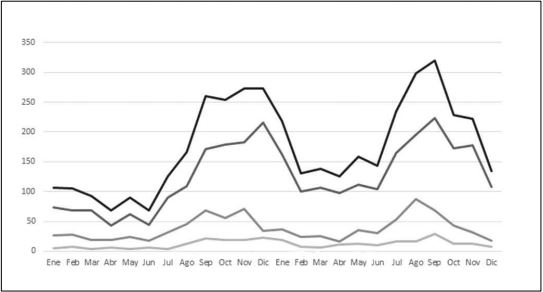This graph shows the gender inequality of the didactic resources that make up some of the textbooks corresponding to the last year of Compulsory Secondary Education (ESO). In this sense, we compare the contents of the SM publishing house for the 4th year of ESO, where, after a decade, we can see that the percentage of female characters has increased from 5.1 % in 2007 to 12 % ten years later. In the Anaya publishing house’s edition, for the same year in 2017, the percentage of women exceeds 17%. Although this does not represent a significant advance, it does mean that the number of male characters has decreased from around 95 % to less than 88 % in 2017. Despite a slight change in the arrangement and balance of the material chosen, the fact is that the figure and prominence of men in the story continue to be prioritised, making the role of women largely invisible.
Collection: Graphics
Project: 8. Women and the change for gender equality in Europe.
Chronology: XV, XVI, XVII, XVIII
Scope: Secondary Education, Baccalaureate, University
Link: https://doi.org/10.18239/jornadas_2020.27.58
Resource type: Graph
Format: Bar chart
Source: Maldonado Cid, D. (2020). “Mujeres olvidadas en la Historia. Estereotipos e invisibilidad en los libros de texto”, en García González, F.; Gómez Carrasco, C. J.; Cózar Gutiérrez, R.; y Martínez Gómez, P. (coords.) La Historia Moderna en la enseñanza secundaria. Contenidos, métodos y representaciones, Cuenca, Ediciones de la Universidad de Castilla-La mancha, p. 700.
Language: Spanish
Date: 2020
Owner: Daniel Maldonado Cid (Modernalia)
Copyright: © Daniel Maldonado Cid
Abstract: Stereotypes and female invisibility in the textbooks of 4th year of Compulsory Secondary Education
Tags






